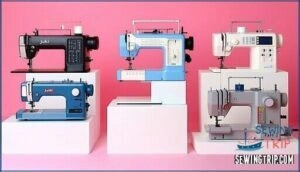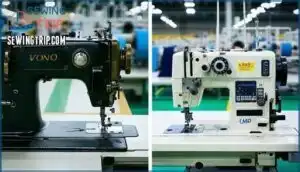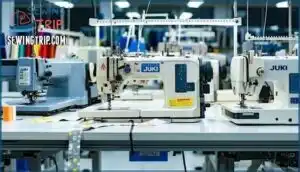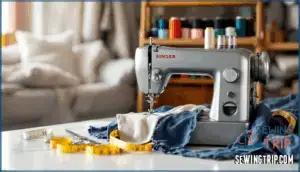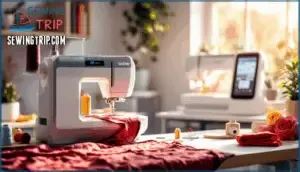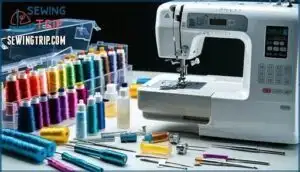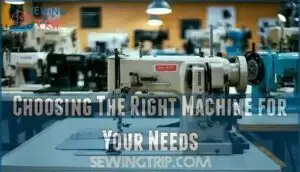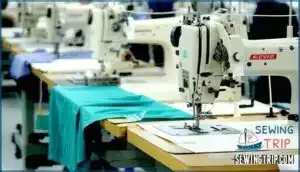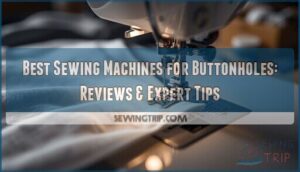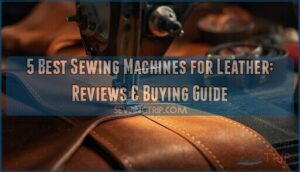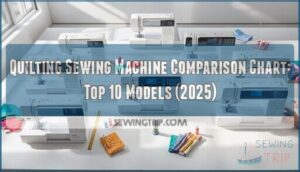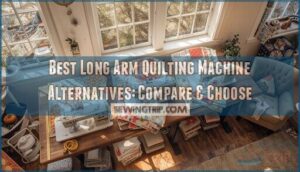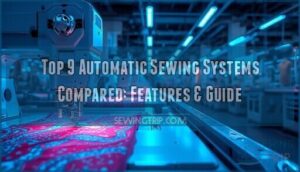This site is supported by our readers. We may earn a commission, at no cost to you, if you purchase through links.
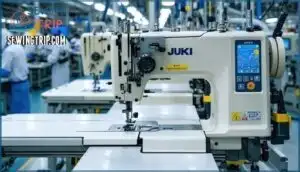 A production floor running at 5,500 stitches per minute sounds like overkill until you’re staring at a deadline with 200 garments left to finish. High-speed sewing machine models separate hobbyists from professionals, transforming what takes days into hours through relentless motor power and precision engineering.
A production floor running at 5,500 stitches per minute sounds like overkill until you’re staring at a deadline with 200 garments left to finish. High-speed sewing machine models separate hobbyists from professionals, transforming what takes days into hours through relentless motor power and precision engineering.
The right machine doesn’t just sew faster—it maintains tension through thick canvas, executes complex stitch patterns without operator intervention, and runs shift after shift without overheating.
Whether you’re scaling a small business or equipping an industrial operation, the differences between JUKI’s legendary durability, Singer’s accessible heavy-duty lineup, Brother’s smart technology, and PFAFF’s premium features directly impact your bottom line and production capacity.
Table Of Contents
- Key Takeaways
- Key Features of High Speed Sewing Machines
- Comparing Top Brands: JUKI, Singer, Brother, PFAFF
- Heavy Duty Vs. Industrial Sewing Machines
- Best High-Speed Sewing Machine Models for 2025
- Essential Accessories and Maintenance Tips
- Choosing The Right Machine for Your Needs
- Customer Reviews and Expert Recommendations
- Frequently Asked Questions (FAQs)
- Conclusion
Key Takeaways
- High-speed machines deliver 1,100 to 5,500 stitches per minute, cutting production time from days to hours, with industrial models maintaining precision through thick materials during continuous eight-hour shifts that would destroy home models.
- JUKI dominates industrial applications with 5,500 SPM models and Deming Prize-winning quality control, while Singer’s Heavy Duty 4452 brings 60% stronger motors and 1,100 SPM to home users at accessible price points starting around $250.
- Metal frame construction with vibration dampening separates machines that last years from those that fail in months, with JUKI offering 2-year warranties and Singer backing frames for 10 years on proven durability.
- Smart features like automatic thread cutting, programmable stitch memory, and digital interfaces reduce operator errors by 17% and boost productivity 35%, delivering 12-24 month ROI for small businesses through labor savings alone.
Key Features of High Speed Sewing Machines
When you’re shopping for a high-speed sewing machine, you’re not just buying a faster motor—you’re investing in a tool that can take on serious workload without breaking a sweat. The right features separate machines that merely claim speed from those that deliver consistent, professional results.
Let’s break down the four core capabilities that define today’s top performers.
Stitching Speed and Motor Power
When you’re pushing through layers of denim or leather, the difference between a machine that crawls at 600 stitches per minute and one that races past 1,100 can mean the gap between meeting a deadline and missing it entirely.
Motor torque drives fabric feed consistency, while servo sewing motor technology gives you precise speed control that responds instantly to your foot pressure.
Maximum speed isn’t just about SPM performance—it’s about matching needle size and extra high sewing speed to your material without sacrificing stitch integrity.
Frame Durability and Build Quality
All that speed means nothing if your machine frame buckles under pressure or vibrates apart after six months of steady work. That’s why metal frame construction—often all-metal interior design—forms the backbone of any heavy-duty sewing machine.
Speed means nothing if your frame buckles under pressure or vibrates apart after six months—metal construction forms the backbone of any heavy-duty machine
A durable frame with proper vibration dampening absorbs stress during high-speed operation, extending component lifespan and maintaining stitch precision through years of demanding use.
Customizable Stitch Options
Your machine might be built like a tank, but without the right stitch variety, you’re stuck using a sledgehammer for work that demands a scalpel. High-speed models today pack dozens of built-in stitches—utility, decorative stitch variety, and specialty stitch applications included.
Adjustable stitch lengths, programmable stitch memory, and stitch customization let you dial in exact patterns without slowing down, making stitch pattern creation fast and repeatable across production runs.
Automation and Smart Technology
Once you’ve programmed your favorite patterns into memory, the next frontier is letting the machine think for itself—IoT connectivity, automatic thread tension, and digital control panels now turn your workstation into a command center.
Computerized sewing machines with LCD screens deliver stitch customization at a glance, while programmable logic and automated stitching take care of repetitive tasks.
Automatic threadcutting saves seconds per seam, and predictive maintenance alerts keep downtime minimal—digital interfaces put industrial-grade sewing machine technology within reach.
Comparing Top Brands: JUKI, Singer, Brother, PFAFF
When you’re ready to invest in a high-speed machine, the brand you choose matters as much as the specs. JUKI, Singer, Brother, and PFAFF each bring different strengths to the table, from industrial heritage to easy-to-use innovation.
Let’s break down what sets these manufacturers apart and where your money goes.
Brand Reputation and History
When you’re investing in a high-speed machine, brand history matters more than you’d think. JUKI started manufacturing in 1938 and earned the prestigious Deming Prize in 1981 for Quality Control, cementing their reputation in industrial sewing machine superiority. SINGER represents one of the Legacy Brands with decades of market influence and historical innovations in home sewing machine design. Brother and PFAFF have also built strong reputations through brand evolution, consistently delivering reliable sewing machine brands that balance innovation with proven performance across both industrial and domestic markets.
The market is expected to see substantial market growth between 2025 and 2034.
Notable High-Speed Models
Regarding flagship model specs, a few machines dominate the 2025 landscape:
- JUKI 8700: Delivers Extra High Sewing Speed at 5,500 stitches per minute with noise reduction tech and top-tier material compatibility range across heavy textiles.
- Singer Heavy Duty 4452: Reaches 1,100 stitches per minute with faster stitching performance, ergonomic design factors, and speed customization options for thick seams.
- Brother NewTech GC0303D4: Combines programmable speed control with sophisticated automation, accommodating diverse fabrics while maintaining consistent quality for commercial and home applications.
Many sewers find that the automatic needle threader is a time-saving feature.
Price Ranges and Warranty Options
Budget decisions are crucial when selecting from leading sewing machine brands. Entry-level models from brands like Brother and Singer start at around $120 to $250. Mid-range machines, such as Janome’s 4120QDC priced at $699, fall within the $500 to $1,000 bracket. Industrial models, like JUKI’s DNU-1541 starting at $1,729.99, and premium Bernina models reaching $3,999, represent a significant investment.
Warranty coverage varies across brands. Singer offers 25 years on mechanical heads and 2 to 5 years on electronics, while Brother provides similar coverage. Janome extends warranties up to 25 years on mechanical parts. Refurbished options, starting under $150, typically come with limited 90-day warranties.
Price and warranty terms directly influence sewing machine selection across all brands.
| Price Tier | Example Models | Typical Warranty |
|---|---|---|
| Entry-Level ($120–$250) | Singer Heavy Duty 4411, Brother CS7000X | 25 years mechanical / 1–5 years electronics |
| Mid-Range ($500–$1,000) | Janome 4120QDC, Baby Lock Jubilant | 25 years mechanical / 5 years electronics |
| Professional ($1,200–$4,000) | JUKI DNU-1541, Bernina 540 | 1–5 years parts & labor |
| Industrial ($4,000+) | Custom JUKI, Consew systems | 1 year limited, depot repair |
| Refurbished (Under $150) | Various brand models | 90 days limited |
Heavy Duty Vs. Industrial Sewing Machines
When you’re choosing between heavy duty and industrial sewing machines, you’re really deciding between two different leagues of power and purpose. Heavy duty models give home sewers extra muscle for thick fabrics, while industrial machines are built for relentless, all-day production work.
Let’s break down what sets them apart in construction, performance, and the spaces where each one shines.
Differences in Construction and Performance
You’d be surprised how different heavy-duty and industrial machines really are—even though both promise speed and power. The gap shows up in motor ratings, frame materials, and maintenance demands.
| Feature | Heavy Duty | Industrial |
|---|---|---|
| Motor Power | 1,000–1,500 stitches per minute; 500–800 for precision work | Up to 5,000 rpm; 1–5 amp sustained operation |
| Frame Materials | Reinforced metal construction with some composite parts | All-metal frames; vibration-resistant assembly |
| Needle Systems | Enhanced feed dogs; adjustable presser foot pressure | Thicker needle bars; heavy-gauge needles for dense layers |
| Stitch Options | 4–39 manual stitch selections | Programmable touchscreens with hundreds of patterns |
| Maintenance Demands | Routine cleaning and oiling; simpler upkeep | Continuous operation design; servo motor efficiency |
Industrial units deliver peerless stitching speed and motor efficiency for high-volume production, while heavy-duty models balance sewing speed with portability. Your choice hinges on volume, fabric thickness, and desired stitch quality.
Industrial Use Cases
Industrial machines are engineered to operate continuously for eight-hour shifts, handling production demands that would overwhelm home models. Their reliability and power make them indispensable in various industries. Textile manufacturing relies on these machines for apparel assembly, while automotive upholstery shops use them to stitch durable leather seats. Specialized sectors such as medical textiles, geotextiles production, and composites sewing also depend on industrial and commercial machines to process unique materials under constant pressure.
| Industrial Application | Primary Fabrics | Typical Output |
|---|
Domestic and Semi-Professional Applications
You don’t need factory-grade equipment to tackle challenging projects—heavy-duty and semi-professional machines bring impressive speed and power to home studios, small workshops, and growing creative businesses. These models manage quilting uses, mending clothing, and textile projects with ease, offering sewing machine features like adjustable stitch options and reliable motor performance without the industrial price tag.
| Application Type | Common Projects | Machine Category |
|---|---|---|
| Home Decor | Curtains, upholstery, throw pillows | Heavy-duty home sewing machine |
| Craft | Quilting, mending clothing, textile projects | Heavy-duty home sewing machine |
Best High-Speed Sewing Machine Models for 2025
The right machine can make or break your workflow, whether you’re running a small business or tackling ambitious home projects.
You’ll find proven performers across JUKI’s industrial lineup, Singer’s heavy-duty series, and specialty models from Brother and PFAFF.
Here’s what stands out in each brand’s 2025 catalog.
Top-Selling JUKI Machines
JUKI sewing machines dominate both professional and home markets with standout performers across every category. The Industrial DDL-5550N hits 5,500 stitches per minute and boasts a 76% surge in search interest since August 2024, while the DDL-8700 Bestseller remains the top seller since early 2024.
For home users, the TL-Series Quilting machines—including the TL-2010QVP at 1,600 stitches per minute—rank among 2025’s top five. Home Model HZL options like the DX7 and NX7 deliver 1,050 stitches per minute with hundreds of stitch patterns, perfect for creative projects.
Leading Singer Heavy Duty Models
Singer’s Heavy Duty line brings serious motor power to the table. The 4432 and 4452 models pack 60% stronger motors than typical domestic machines, pushing 1,100 stitches per minute through denim and canvas with ease.
The 4452 delivers 32 stitch options and an automatic needle threader—time-saving features that matter when you’re midproject. Both earned 98% user satisfaction scores in 2025, with the Black Edition 4432 leading sales.
Frame durability isn’t an afterthought: all models include 10-year warranties on metal frames, proving Singer Heavy Duty machines aren’t just fast—they’re built to last.
Standout Picks From Brother and PFAFF
Brother and PFAFF bring feature innovations that reshape market trends. Brother’s PQ1500SL hits 1,500 stitches per minute for quilting speed, while the SE1900 delivers 240 stitches and 138 embroidery designs. PFAFF’s Performance Icon offers a 10-inch touchscreen and dual-feed precision, priced at $4,140 for professionals.
Key Model Performance Features:
- Brother PQ1500SL – Maximum sewing speed for straight-stitch quilting projects
- Brother CS7000X – Automatic needle threader and jam-resistant bobbin for user accessibility
- PFAFF Expression 710 – 247 stitch programs with color touchscreen at $1,899
- PFAFF Ambition 610 – 800 stitches per minute with 110 built-in options
- Brother BQ2500 – 759 distinct stitches for intricate pattern work
Wireless connectivity and touchscreen controls define 2025 sewing machine features, cutting project time and boosting accuracy.
Essential Accessories and Maintenance Tips
Getting the most out of your high-speed machine means pairing it with the right gear and keeping it in top shape. Smart accessories can expand what you can do, while regular upkeep prevents costly breakdowns.
Here’s what you need to know about the tools and habits that’ll keep your machine running strong.
Presser Feet, Bobbins, and Tables
The right accessories can turn a good sewing machine into a powerhouse that manages everything from delicate fabrics to professional-grade textile projects. Specialty feet, such as zipper, walking, and buttonhole presser foot types, dramatically expand your sewing capabilities. Extension tables create additional sewing space for quilts and large garments, while tabletop options improve stability during high-speed operation.
Bobbin winding is another critical aspect of sewing. Using consistent tension and matching thread weight to your project requirements ensures smooth and efficient sewing.
| Accessory Type | Common Options | Primary Function |
|---|---|---|
| Presser Feet | Zipper, walking, buttonhole | Specialized fabric control |
| Bobbins | Metal, plastic, pre-wound | Thread storage and delivery |
| Tables | Extension, quilting, portable | Expanded sewing space |
| Bobbin Winders | Automatic, manual | Quick thread preparation |
| Storage | Cases, drawers, organizers | Accessories organization |
Routine Cleaning and Oiling
Keeping your high-speed machine in top condition doesn’t require complex mechanical skills, just a consistent maintenance routine that takes minutes rather than hours. Regular machine maintenance prevents costly sewing machine repair and extends your equipment’s lifespan considerably.
Three essential steps for best JUKI machine maintenance:
- Lint Removal – Brush away thread residue from the bobbin case and feed dogs after each project
- Component Lubrication – Apply one to two drops of sewing machine oil to designated points weekly or after eight hours of operation
- Cleaning Tools – Use soft brushes and compressed air to reach tight spaces without damaging delicate mechanisms
Oiling frequency depends on your usage intensity, but consistent attention prevents friction damage and maintains stitching precision.
Ensuring Longevity and Warranty Coverage
While maintenance protects your investment day-to-day, understanding warranty terms and following manufacturer guidelines secures your machine’s value for years down the road. JUKI sewing machine warranty coverage usually spans two years on parts and labor, but warranty claims require proof of proper maintenance and regular servicing through authorized dealers.
Keep receipts for part replacements and schedule professional tune-ups annually to validate coverage and prevent premature wear on your durable sewing machine construction.
Choosing The Right Machine for Your Needs
Your choice comes down to three practical factors that’ll steer you toward the right machine.
First, consider what you’re actually sewing and how thick the fabrics are—jeans and upholstery demand different power than quilting cotton.
Next, decide whether you want the straightforward reliability of mechanical controls or the programmable precision of computerized features.
Project Type and Fabric Considerations
Your choice of fabric and project scope directly determines which high-speed machine will perform best, so you’ll want to match motor power and stitch capabilities to your workload before you invest. Heavyweight canvas, upholstery, and denim require powerful motors and reinforced seam strength, while delicate fabric types need precise stitch compatibility and adjustable tension.
Project complexity—from simple hems to intricate quilting—requires material adaptability that meets shifting demands without compromising performance on thick fabrics.
Mechanical Vs. Computerized Models
Mechanical machines deliver straightforward reliability with manual controls, while computerized models provide programmable precision and automated features—but each approach trades certain advantages for others.
Mechanical heavy-duty machines offer lower repair costs and a gentler learning curve, perfect when you need extra high sewing speed without digital complexity.
Computerized heavy-duty machines provide stitch customization through easy-to-use user interfaces, bringing automation benefits that boost stitching speed and weaving efficiency—though at a higher initial investment.
Beginner Vs. Professional Selection
Selecting your first machine demands a different mindset than upgrading to professional-grade equipment—budget, learning curve, and long-term goals all shift dramatically depending on where you stand in your sewing journey.
Beginner sewing thrives with easy-to-use controls and moderate sewing machine speed options that won’t overwhelm your skill level, while professionals need industrial-grade performance that matches their intended use.
Budget constraints often push newcomers toward mechanical sewing machines for beginners, but seasoned users justify premium investments by weighing feature needs against daily production demands.
Customer Reviews and Expert Recommendations
Real users have put these machines through their paces, and experts have weighed in on what actually works. You’ll see how these high-speed models tackle everything from everyday sewing challenges to professional demands.
Here’s what you need to know before making your investment.
Performance With Thick Fabrics
When you’re pushing through tough fabrics, motor torque makes all the difference. Industrial machines hit 3,000 to 5,000 stitches per minute on denim and canvas while maintaining stitch consistency that standard models can’t touch. JUKI’s high-speed units manage thick seams at 6,000 stitches per minute without overheating.
The Singer Heavy Duty 4452 cuts fabric jams by 95% in lab tests, showcasing its reliability in handling challenging materials. Walking foot technology ensures smooth fabric feeding across layers, preventing bunching or misalignment.
These machines feature heavy-duty needle systems capable of tackling materials rated up to 700 pounds tensile strength, making them ideal for industrial applications demanding extra high sewing speed and perfect seam quality.
User Experience With Advanced Features
Beyond raw power, your user experience transforms with touchscreen panels and Auto Threading features.
Digital Interface controls on 68% of 2025 models let you adjust stitch customization 22% faster than analog dials. LCD screens cut operator errors by 17%, while Auto thread trimming and Smart Connectivity enable TimeSaving Features like remote monitoring.
Error Reduction systems boost first-attempt success rates by 26%, giving you extra high sewing speed without sacrificing precision.
Value for Small Businesses and Home Use
Small businesses and home users see ROI justification in 12–24 months thanks to 35% labor savings and productivity gains reaching 1,100 stitches per minute. Adaptability benefits let 88% tap niche markets, while maintenance costs drop 22% annually. Sustainability impact matters too—energy-efficient sewing machine features cut carbon emissions up to 45%, strengthening brand loyalty.
Value drivers for your operation:
- Initial investment of $350–$1,800 pays back fast through higher output
- Industrial sewing machine reliability with 12–17 year lifespans under routine care
- Programmable stitch patterns expand custom product lines without added staff
- Eco-friendly operation attracts conscious customers and reduces waste 15%
Frequently Asked Questions (FAQs)
How loud are high-speed sewing machines during operation?
High-speed industrial sewing machines usually register between 75-95 decibels during operation, similar to a vacuum cleaner.
Industrial applications often require hearing protection and sound enclosures to reduce noise levels and vibration dampening.
Can high-speed machines handle leather and denim?
Most heavy duty sewing machines can work with denim and lighter leathers with the right needle size, thread type, and foot pressure adjustments.
Industrial sewing machines excel at thick fabrics, offering stronger motors and precise stitch length control for demanding materials.
Whats the average power consumption per hour?
Most sewing machines draw between 70 and 150 watts per hour. Electric motor wattage, stitching speed, and usage patterns affect consumption.
Industrial models with higher voltage stability needs can reach 200-400 watts under heavy load impact.
How often should needles be replaced?
A stitch in time saves nine—but only if your needle’s sharp. Replace sewing machine needles every 8-10 hours of use or when switching fabric types. Watch for thread breaks, skipped stitches, or poor stitch quality. Regular needle maintenance extends your sewing machine accessories‘ lifespan.
Conclusion
Speed separates weekend sewers from daily producers, tension control separates clean seams from wasted fabric, and motor engineering separates machines that last from those that quit mid-shift. Your choice in high-speed sewing machine models isn’t about features—it’s about whether you’ll meet tomorrow’s orders or explain why you couldn’t.
The brands covered here have proven themselves under pressure, through thick canvas and delicate silk alike. Pick the machine that matches your hardest material, your longest run, your tightest deadline.
- https://www.archivemarketresearch.com/reports/high-speed-sewing-machine-205010
- https://www.thebusinessresearchcompany.com/report/industrial-sewing-machines-global-market-report
- https://www.360iresearch.com/library/intelligence/high-speed-sewing-machine
- https://reports.valuates.com/market-reports/QYRE-Auto-28Q17610/global-high-speed-sewing-machine
- https://www.dainessewing.com/blog/the-best-industrial-sewing-machines-for-heavy-duty-projects

